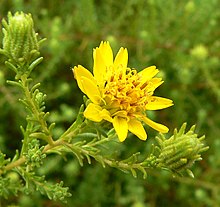Deinandra minthornii
| Deinandra minthornii | |
|---|---|

| |
| Scientific classification | |
| Kingdom: | |
| (unranked): | |
| (unranked): | |
| (unranked): | |
| Order: | |
| Family: | |
| Subfamily: | |
| Tribe: | |
| Genus: | |
| Species: | D. minthornii
|
| Binomial name | |
| Deinandra minthornii | |
| Synonyms[1] | |
|
Hemizonia minthornii Jeps. | |
Deinandra minthornii — (syn. Hemizonia minthornii) — is a rare California species of flowering plant in the aster family known by the common name Santa Susana tarplant, or Santa Susana tarweed. It is an endangered species, listed as a Threatened species by the California Department of Fish and Game,[2] as Imperiled under the California Endangered Species Act—CESA,[3] and on the California Native Plant Society Inventory of Rare and Endangered Plants of California.[3]
Distribution
Deinandra minthornii (Hemizonia minthornii) is endemic from the Santa Susana Mountains, through the Simi Hills, to the Santa Monica Mountains of the southwestern Transverse Ranges, in Los Angeles and Ventura Counties, Southern California.[4][5][6][7]
This plant grows in the coastal sage scrub and chaparral habitats of the coastal sage and chaparral, and the chaparral habitat of the adjacent inland the montane chaparral and woodlands. It can be found on rocky outcroppings and in sandstone crevices, from 300–500 metres (980–1,640 ft) in elevation.[4][6] There are about 20 occurrences of the plant, but several have not been observed recently.[5]
Description
Deinandra minthornii is a shrub or subshrub growing 15 centimetres (5.9 in) to 1 metre (3.3 ft) in height. The stems are hairy, glandular, and leafy. The thick leaves are linear, smooth-edged or with a few teeth. They are glandular and hairy to bristly.[8]
The phyllaries lining the flower heads are coated in glands. The head contains four to eight yellow ray florets and several yellow disc florets.[6][8]
References
- ^ The Plant List, Deinandra minthornii (Jeps.) B.G.Baldwin
- ^ California Department of Fish and Game: Threatened and endangered plants (1 October 2011) . accessed 6.12.2012
- ^ a b California Native Plant Society (CNPS). 2012. Inventory of Rare and Endangered Plants (online edition, v8-01a). California Native Plant Society. Sacramento, CA. . accessed 6.12.2012
- ^ a b Hemizonia minthornii. The Nature Conservancy.
- ^ a b Hemizonia minthornii. Center for Plant Conservation.
- ^ a b c Hemizonia minthornii. Jepson. accessed 6.12.2012
- ^ Calflora taxon report, University of California, Deinandra minthornii (Jeps.) B.G. Baldwin, Santa Susana tarplant
- ^ a b Deinandra minthornii. Flora of North America.
External links
- NatureServe imperiled species
- Deinandra
- Endemic flora of California
- Natural history of the California chaparral and woodlands
- Natural history of the Santa Monica Mountains
- Natural history of Los Angeles County, California
- Natural history of Ventura County, California
- Natural history of the Transverse Ranges
- Santa Susana Mountains
- Simi Hills
- Plants described in 1925
- Taxa named by Willis Linn Jepson
- Critically endangered flora of California

